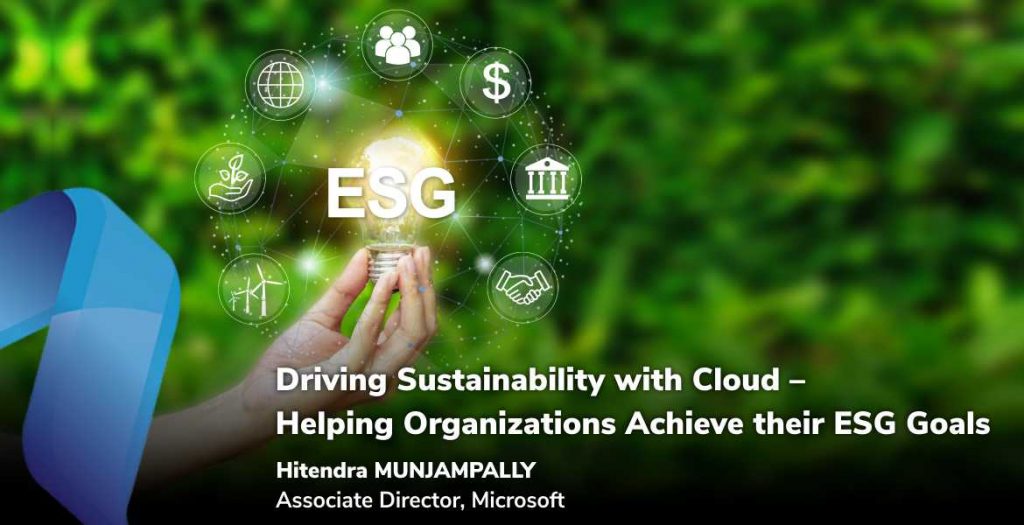These days there is much talk about Environmental, Social, and Governance (ESG) and how organizations must assess their impact on the society and the overall environment. But what does that really mean? And how can you make sure your organization is making the most responsible choices when it comes to technology infrastructure?
Organizations need to be able to register their environmental footprint, inform stakeholders, lower their resource use, remove their footprint via carbon offsets or recycling, and replace high-footprint resources with low-footprint ones. But performing this efficiently means driving away from manual data entry into spreadsheets towards a more seamless data flow via data connectors that deliver automatic, precise, real-time data — and finally, turning those data-driven insights into actions.
Seamless data flow is crucial for driving informed decisions regarding the origin of the organization’s environmental footprint and where strides can be made to reduce it. Data connectors make it possible to automatically pull in data from disparate sources and consolidate it into a single view. This not only saves time and eliminates errors associated with manual input but also provides a complete picture that can be used to identify areas of improvement. In addition, data connectors can provide real-time data, which is essential for reacting quickly to changes in resource usage. Ultimately, data connectors can help organizations to continuously monitor their environmental footprint and make the necessary adjustments to reduce it.
The challenge to move to net-zero emissions and halt the damage from the last two centuries of industrialization can seem daunting. Still, many organizations across multiple industries are embracing it. When it comes to sustainability, Microsoft is no novice. The company has been operationalizing its sustainability plan for over a decade now, developing tools and methods that other businesses can replicate along the way. Sustainability always has been at the core of Microsoft’s business model. With increasing regulation and customer demand for positive change, the company is more committed than ever to continuing its work in this area. Microsoft Cloud for Sustainability is the first horizontal industry cloud devised to work across multiple industries. Its solutions can be customized to exact industry needs, whether a customer is in manufacturing, retail, energy, or another industry. At its core is a data model which aligns with Greenhouse Gas Protocols—the standard in recognizing and recording emissions information. Microsoft Cloud for Sustainability also reflects Microsoft’s deep relationships with partners to provide solutions to solve critical customer needs and customer problems. Whether a customer is looking to reduce their carbon footprint or improve their bottom line, Microsoft Cloud for Sustainability has the tools they need. And with the power of the cloud behind it, this sustainable solution will make a lasting impact.

By bringing together the power of technology with the passion of people, organizations can accelerate sustainability progress and drive positive change in the world.
– Hitendra Munjampally Associate Director, Microsoft MOURI Tech
What is Microsoft Cloud for Sustainability?
Microsoft Cloud for Sustainability enables organizations to achieve their sustainability aspirations while driving business growth.1 The cloud service is purpose-built to give organizations the capabilities they need to manage and report on their ESG performance. The service provides access to a range of data and analytics tools that make it easy for organizations to track progress and identify areas for improvement. In addition, Microsoft Cloud for Sustainability makes it possible for organizations to engage with their stakeholders on ESG issues, enabling them to build trust and drive change. The service is also backed by a community of sustainability experts who can provide guidance and support. By bringing together the power of technology with the passion of people, Microsoft Cloud for Sustainability is helping organizations to accelerate sustainability progress and drive positive change in the world. Microsoft Cloud for Sustainability is Microsoft’s latest effort to help organizations build a sustainable future. It includes Microsoft solutions across four key areas of investment:
- Unifying data intelligence
- Building a sustainable IT infrastructure
- Reducing the environmental impact of operations
- Creating sustainable value chains
Each of these solutions is designed to empower organizations in their sustainability efforts, and together they provide a comprehensive approach to sustainability.

Unifying Data Intelligence: Sustainability reporting is quickly becoming a staple for businesses across various industries. To stay competitive, companies must be able to collect and manage data related to their sustainability efforts effectively. Microsoft Sustainability Manager is designed to help businesses unify their data intelligence and gain the visibility they need to improve their sustainability reporting.2 The platform enables organizations to easily input, extract, and understand data related to emissions and other sustainability metrics. Additionally, the prebuilt calculation models allow businesses to see results quickly and configure calculations to support their specific needs. The consistency delivered by the data model enables more accurate and reliable reporting, helping companies transform their operations and become leaders in sustainability.
Building a Sustainable IT Infrastructure: As businesses strive to become more sustainable, they are looking for ways to reduce their carbon and energy emissions. One way to do this is to migrate workloads to the cloud. Microsoft Azure can help businesses reduce emissions by providing more efficient tools, systems, and activity options. The Azure Migration and Modernization Program employs system integrator partners to drive cloud workload migration for customers & has been a critical investment that ultimately enables these sustainability benefits.3 To help businesses calculate the sustainability effect of migrating to the cloud, Microsoft introduced the Emissions Impact Dashboard (EID) in October 2021.4 This dashboard will enable enterprises to verify emission data to make informed decisions about their sustainability efforts.
Reduce the Environmental Impact of Operations: To reduce the ecological effects on industrial processes, Microsoft has partnered with Johnson Controls, Inc (JCI) to introduce the OpenBlue Enterprise Manager solution suite.5 This solution is designed to help organizations drive sustainability progress by reducing, removing, and replacing processes with a high environmental impact. The OpenBlue Enterprise Manager suite includes tools for reducing energy consumption, creating smart facilities, and collaborating on sustainability goals. Microsoft hopes to minimize the environmental footprint of operational processes and systems by using this solution. In addition to the OpenBlue Enterprise Manager suite, Microsoft is also focused on creating intelligent facilities and developing planning tools that will help further reduce our environmental impact.
Create Sustainable Value Chains: To create sustainable value chains, transparency throughout an organization’s value chain is imperative. Accurate and reliable upstream and downstream data can achieve this. Most of this data is managed through survey-based information or by manually obtaining supplier ratings and data. For example, EcoVadis rates more than 90,000 companies on their sustainability. Microsoft and EcoVadis have partnered to surface rating data alongside the supplier data in Microsoft Cloud for Sustainability analytics and reporting experiences. Organizations can use this information to inform supplier selection by ingesting supplier ESG ratings, emissions, etc. Creating sustainable value chains is possible with the help of technology and by being transparent with an organization’s data.
Conclusion
Sustainability has become more than a buzzword in recent years as more businesses seek to operate more environmentally responsibly. However, the sustainability journey can be long and complicated, and it can take time to know where to start. That’s where Microsoft Cloud for Sustainability comes in. It provides businesses with the ESG capabilities they need to accelerate their progress toward net zero. From reducing carbon emissions to improving resource efficiency, Microsoft Cloud for Sustainability can help your business make a real difference.
Microsoft has long been a leader in sustainable business practices, and the company is committed to embedding sustainability throughout its organization and value chain. Microsoft and its partners enable organizations to acquire the clarity and insights they require to oversee their environmental footprint, ingrain sustainability through their organization and value chain, and make strategic business investments that drive value. These solutions help organizations apprehend their consequence on the environment, determine opportunities for improvement, and track progress over time.
In addition, Microsoft is working with its partners to create innovative solutions that enable organizations to reduce their environmental impact, improve resource efficiency, and optimize operations. MOURI Tech has the expertise in developing ESG and sustainability solutions that reduce the environmental impact of operations, deploy and use nimble and smart infrastructure, and monitor and improve sustainability reporting.
Reference Links:
- https://www.microsoft.com/en-us/sustainability/cloud?rtc=1
- https://www.microsoft.com/sustainability?rtc=1
- https://azure.microsoft.com/migration/migration-modernization-program/
- https://appsource.microsoft.com/product/power-bi/coi-sustainability.emissions_impact_dashboard
- https://azuremarketplace.microsoft.com/
Author Bio:
Hitendra Munjampally
Associate Director, Microsoft
Hitendra has a strong track record of leading and enabling teams to deliver cutting-edge IT solutions to enterprise customers across Hi-Tech, Manufacturing & Health, Energy & Utilities, Travel & Logistics and Services industry domains. He has extensive experience in developing IT strategy, next-gen service offerings, pre-sales, technology solutions & accelerators to help customers digitalize and modernize their workloads, leveraging Microsoft capabilities.






